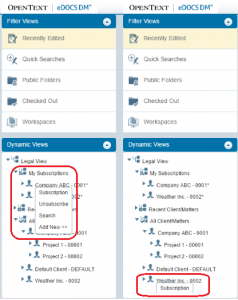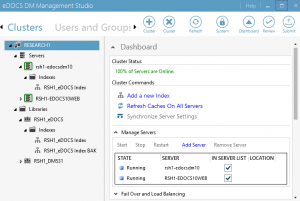Now that OpenText eDOCS DM 10 has been officially released, we wanted to take a little time and get familiar with what is included in the final release. OpenText’s most advertised innovations in the release of eDOCS DM 10 revolve around an enhanced user experience. Updated dialog boxes and forms reflect these changes by providing users with a more modern interface that is simple and intuitive. However, for firms that have leveraged the web platform for DM, the more impactful upgrade for users might be the new DM 10 “Light” WebTop. The DM 10 Web Server can be installed independently from the now “Classic” Web Server, which is still available and can to be used in addition to the new Web Server and Webtop. Another key new feature, the DM Management Studio, is aimed at IT administrators.
DM 10 Webtop

The new Webtop design is consistent with the updated dialog boxes and forms present within integrated applications and the Windows Explorer DM Extension. It is a refreshing change from the cluttered and outdated Classic Webtop experience. The new interface appears much less complex than the classic, yet it provides the same functionality for users by eliminating redundant buttons, action panes, and tabs. Furthermore, the new site explicitly labels large, obvious buttons instead of the sporadic placement of small icon buttons on the classic Webtop. The “Light” Webtop also provides additional search functionality by incorporating Dynamic Views, using the same structure displayed in the DM Windows Explorer Extension.
Despite significant interface improvements to the DM web experience, there are minor drawbacks to the functionality of the “Light” Webtop. There are bugs with the display functionality of actions available through Dynamic Views that OpenText will need to resolve. Hovering over nodes displays a list of available options, but the list is cut off where the Dynamic Views pane ends, tested and verified in both Chrome and Internet Explorer browsers (see the image to the right).
There is also some confusion seen regarding grayed-out options in the context menu. The contrast between an available option and a “grayed-out” option (due to lack of permissions) is almost negligible, so it is initially unclear what the end user is be able to do.
Another drawback is that administrative tools and settings are not available in the new interface. IT administrators looking to replace the classic webtop with the new one will not be able to accomplish the same administrative tasks through the new webtop. Perhaps these features will be added in the future, but they are not included in the initial release of DM 10.
DM Management Studio
The DM Management Studio is the second significant addition to DM 10. Implementation requires a separate SQL database created by eDOCS directly on the SQL server and a unique SQL login account — it can’t leverage the DOCSADM account. In our testing, we had to let the tool create the actual database. We could not point to a previously created blank database. The studio interface is consistent with the updated design of other DM 10 interfaces, and is broken up into the Clusters tab and the Users and Groups tab.
Within Clusters, FOLB clusters can be created, configured, and maintained in addition to indexes, which are organized by both server location and by library. Administrators are able to refresh all caches on all servers in the cluster, refresh a custom set of caches on all servers, and configure all cache refresh interval settings. These administrative tasks previously required making changes on every server in the cluster. By implementing these changes in one central location, the management studio can cut down time spent maintaining, troubleshooting, and configuring DM clusters. For anyone performs DM server migrations, this tool saves many clicks and headaches!

The “Light” DM Web Server and the DM Management Studio are valuable developments in improving administrator and end user experience. Both interfaces are organized, easy to navigate, and significantly modernized in comparison to the DM Classic Web Server, Server Manager, and Library Maintenance tool. Despite these improvements, the new tools do not necessarily replace the classic ones, so administrators are left with the responsibility of installing and managing these additional DM components on top of what was required for previous versions. It would be ideal if the need for the classic webtop and some of the other administrative tools could be diminished by incorporating administrative functions from the DM Classic Web Server into the “Light” Web Server and by expanding the functionality of the DM Management Studio.